Maintaining a healthy diet often comes down to balancing calorie intake with nutritional value. Zero-calorie foods, though not technically devoid of calories, are often packed with fiber and water, making them incredibly low in calories while providing essential nutrients. These foods are perfect for anyone looking to manage their weight, stay full, or make smarter food choices without compromising on flavor or nutrition.
Building meals around zero-calorie ingredients like cucumbers, celery, or leafy greens? Use ReciMe to save and organize recipes that highlight these ultra-light foods. Whether you’re collecting salad ideas from Pinterest or detox snacks from TikTok, ReciMe lets you store them all in one place, plan your meals for the week, and generate grocery lists focused on low- or zero-calorie ingredients. Download ReciMe and make zero-calorie foods a practical, everyday part of your routine.

1. Spinach
Spinach is an excellent low-calorie food, with just seven calories per uncooked cup. It’s versatile and can be used in various dishes like salads, sautéed as a side, or blended into smoothies. Despite being low in calories, spinach is rich in important nutrients like vitamin K, vitamin A, and folate, which support bone health, immune function, and overall well-being.
Spinach’s low calorie count and nutrient density make it a valuable addition to any diet. It’s easy to incorporate into meals, helping you stay full without consuming excess calories.
Key Highlights:
- Low in calories.
- High in vitamins K, A, and folate.
- Easy to add to a variety of meals.
- Supports overall health.
Who It’s Best For:
- Those aiming to manage or reduce calorie intake.
- Anyone looking to add more nutrients to their diet.
- People seeking a versatile, healthy food option.

2. Cabbage
Cabbage is a low-calorie vegetable that comes in different varieties, including green, white, and red. Each variety offers unique nutrients, with red cabbage having a higher amount of vitamin C compared to green cabbage. Cabbage is also a good source of vitamin K and fiber, which contribute to healthy bones and digestive function.
You can enjoy cabbage in many ways: raw in salads, as part of a low-calorie coleslaw, or steamed as a healthy side dish. Its versatility makes it easy to incorporate into your meals while keeping your calorie intake in check.
Key Highlights:
- Low in calories and nutrient-rich.
- High in vitamin K and fiber.
- Available in different varieties with varying nutrient profiles.
- Can be eaten raw, steamed, or as a side dish.
Who It’s Best For:
- Those looking to eat low-calorie, nutrient-dense foods.
- Individuals seeking to increase fiber and vitamin K intake.
- People who enjoy adding variety to their meals with healthy vegetables.
3. Iceberg Lettuce
Iceberg lettuce is a mild, low-calorie leafy green with high water content, making it a refreshing addition to your diet. It’s incredibly low in calories, offering just one calorie per leaf, making it perfect for those looking to keep their calorie intake in check. Along with being low-calorie, it also provides beneficial nutrients like calcium, potassium, and folate.
This lettuce is versatile and can be used in various ways. You can use it as a base for salads, wrap it around fillings for low-carb tacos, or enjoy it as a crunchy addition to any meal.
Key Highlights:
- Extremely low in calories.
- High in water content, making it refreshing.
- Contains calcium, potassium, and folate.
- Versatile for salads, wraps, and tacos.
Who It’s Best For:
- Those seeking a mild, low-calorie leafy green.
- People looking to boost their intake of potassium and calcium.
- Anyone wanting a versatile ingredient for salads or wraps.
4. Pumpkin
Pumpkin is a versatile vegetable packed with health benefits, making it a great addition to any diet. While it’s often associated with fall and Halloween, it can be enjoyed year-round. Pumpkin is an excellent source of beta-carotene, an antioxidant that supports eye health and immunity. Despite its richness in nutrients, pumpkin remains a low-calorie option, making it easy to fit into various meal plans.
You can use pumpkin in a variety of ways: bake it into treats, add it to soups for a comforting dish, or incorporate it into savory meals. Its naturally sweet flavor and nutrient profile make it an excellent choice for healthy, low-calorie meals.
Key Highlights:
- Rich in beta-carotene, supporting eye health and immunity.
- Naturally low in calories, making it suitable for calorie-conscious diets.
- Versatile for both savory and sweet dishes.
- Can be used in baking or as a comforting soup base.
Who It’s Best For:
- Those looking for a nutrient-dense, low-calorie vegetable.
- Individuals seeking to add beta-carotene to their diet.
- People who enjoy versatile ingredients for both savory and sweet dishes.
5. Pickles
Pickles are a great low-calorie snack, especially if you’re craving something salty. A small dill pickle spear is incredibly low in calories and contains hardly any carbs, making it a perfect occasional snack. Pickles are low in calories and contain sodium, which may support hydration, but their role in muscle recovery is limited due to low electrolyte content.
You can enjoy pickles on their own, as a crunchy addition to meals, or as a flavorful side to various dishes. Their tangy taste and low-calorie count make them an easy and satisfying snack option.
Key Highlights:
- Low in calories and carbs, making them a great snack choice.
- Versatile for snacking or adding crunch to meals.
- Available in a variety of flavors, from dill to spicy.
Who It’s Best For:
- Those looking for a low-calorie, salty snack.
- People needing a quick snack for muscle recovery or electrolyte support.
- Anyone looking to add flavor and crunch to their meals without extra calories.
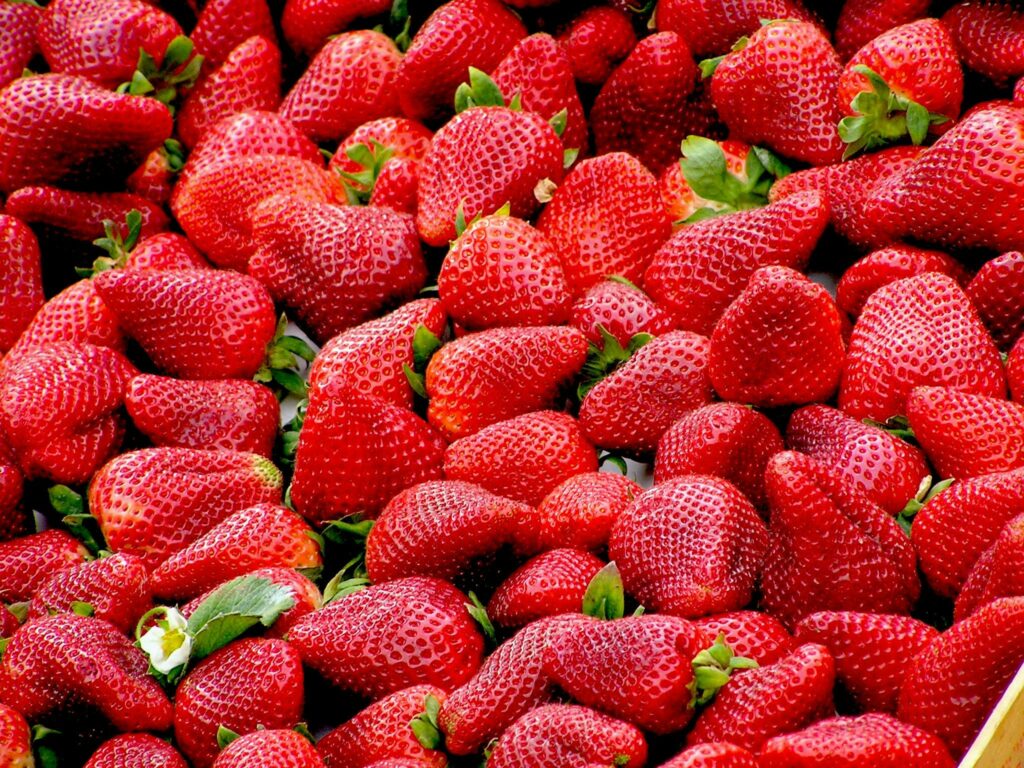
6. Strawberries
Strawberries are a delicious and nutritious fruit that can easily fit into a low-calorie diet. With just a small number of calories per serving, they provide an excellent snack option for those looking to enjoy something sweet without consuming too many calories. In addition to being low-calorie, strawberries are low in calories and high in vitamin C, which supports immune health, with trace amounts of magnesium for nerve function.
These berries are also rich in antioxidants and plant compounds that may help regulate blood sugar levels, making them a great choice for overall health. Strawberries are perfect on their own, but can also be added to salads, desserts, or smoothies to enhance the flavor and nutritional value of your meals.
Key Highlights:
- Low in calories, making them a great snack or meal addition.
- High in vitamin C and magnesium for better nerve function and tissue health.
- Rich in antioxidants and plant compounds, which may help with blood sugar control.
- Versatile for adding to desserts, salads, or enjoying on their own.
Who It’s Best For:
- Those looking for a sweet, low-calorie snack.
- Individuals seeking to boost their intake of vitamin C and magnesium.
- People interested in adding more antioxidants to their diet.
7. Apples
Apples are a widely popular fruit known for their versatility and health benefits. Low in calories and high in fiber, apples make for a satisfying snack or addition to any meal. They are low in calories, high in fiber, and a good source of vitamin C, supporting immune function, with trace amounts of other nutrients.
Apples can be enjoyed in many ways – sliced for a quick snack, added to salads, or incorporated into baked goods. Their natural sweetness and crisp texture make them an easy, low-calorie option for a healthy diet.
Key Highlights:
- Low in calories, making them a great snack or meal addition.
- High in fiber, supporting digestive health.
- A good source of vitamin C and high in fiber.
- Versatile for snacking, salads, or baking.
Who It’s Best For:
- Those looking for a nutritious, low-calorie snack.
- Individuals seeking to increase fiber intake.
- People who enjoy incorporating fruit into their meals.
8. Grapefruit
Grapefruit offers a refreshing citrus flavor that sits somewhere between the sweetness of an orange and the tartness of a pummelo. Known for its low calorie content, half a grapefruit is a satisfying option for those seeking a healthy snack. Grapefruit is low in calories and rich in vitamin C, supporting immune function, with small amounts of beta-carotene for eye health.
This fruit can be enjoyed on its own, added to salads, or used in smoothies. Its tangy taste and high nutrient content make it a great option for anyone looking to boost their vitamin intake without consuming excess calories.
Key Highlights:
- Low in calories, with a refreshing citrus flavor.
- Rich in vitamin C, supporting immune function.
- A good source of beta-carotene for eye health.
- Versatile for snacking or adding to meals.
Who It’s Best For:
- Those looking for a tangy, low-calorie snack.
- People seeking to increase their vitamin C intake.
- Individuals looking to add more citrus fruit to their diet.
9. Papaya
Papaya is a tropical fruit that makes for a delicious and nutritious snack. Despite its sweet flavor, papaya is low in calories, with one small fruit containing only around 59 calories. It’s low in calories and rich in vitamins A and C, supporting skin health and immunity, with trace amounts of vitamin E.
In addition to its impressive vitamin content, papaya’s seeds are known to help combat intestinal parasites, supporting digestive health. This fruit has a smooth texture and sweet taste, making it enjoyable on its own, blended into smoothies, or used in fresh salsas for added flavor.
Key Highlights:
- Low in calories with a naturally sweet taste.
- High in vitamins A, C, and E, promoting skin health and immunity.
- Papaya seeds help support digestive health.
- Versatile for snacking, smoothies, or fresh salsas.
Who It’s Best For:
- Those looking for a tropical, low-calorie snack.
- Individuals seeking to boost their intake of vitamins A, C, and E.
- People interested in adding more tropical fruits to their meals.
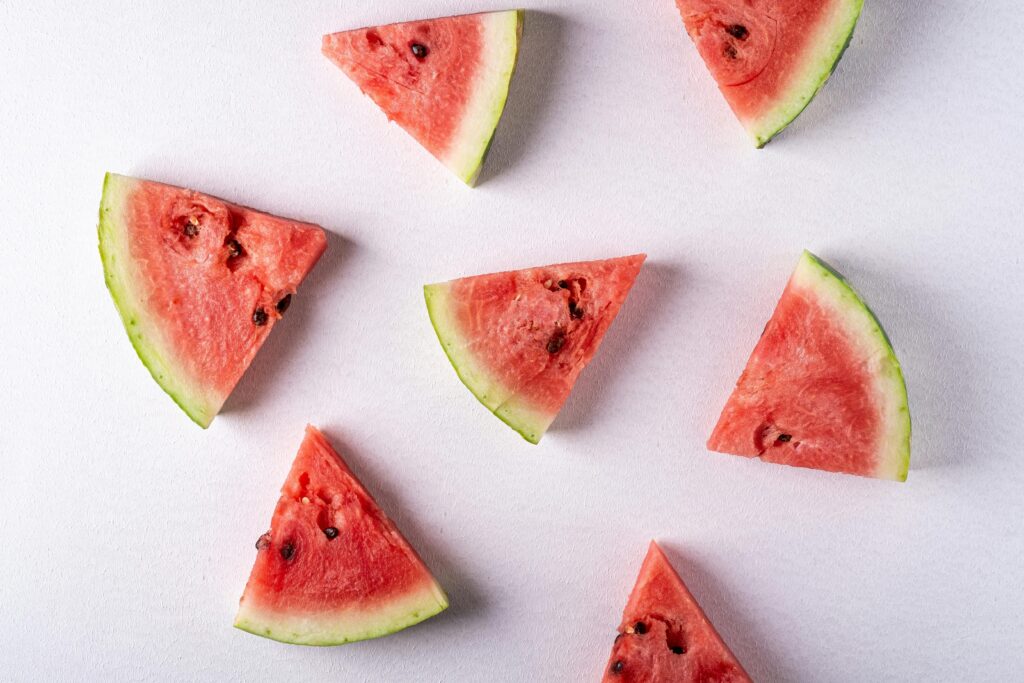
10. Watermelon
Watermelon is a hydrating and refreshing fruit that’s perfect for hot days or as a light snack. With over 90% water content, it’s not only low in calories but also helps keep you hydrated. A cup of watermelon provides a small portion of your daily vitamin C needs, supporting your immune system and skin health.
You can enjoy watermelon on its own, or get creative by pairing it with feta and mint for a unique, refreshing snack that adds a bit more protein to your meal. Its naturally sweet flavor and high water content make it a great option for staying satisfied without consuming many calories.
Key Highlights:
- Low in calories and high in water content.
- Provides a portion of daily vitamin C needs.
- Sweet, hydrating, and refreshing for snacking.
- Can be paired with feta and mint for added flavor and protein.
Who It’s Best For:
- Those looking for a hydrating, low-calorie snack.
- Individuals seeking to boost their vitamin C intake.
- Anyone wanting a refreshing, sweet fruit to enjoy on its own or in meals.
11. Radishes
Radishes are crunchy root vegetables with a spicy, peppery taste that can add a unique flavor to your meals. They’re low in calories, making them a great addition to any diet, while also providing a good source of potassium, folate, and vitamin C, which are important for heart health and immune support.
You can enjoy radishes in various ways, such as paired with a Greek yogurt veggie dip for a healthy snack or added to salads for a bit of crunch. Their distinct flavor and low-calorie content make them a versatile option for adding freshness to your meals.
Key Highlights:
- Low in calories and rich in potassium, folate, and vitamin C.
- Adds a spicy, peppery flavor to dishes.
- Versatile for snacking or adding crunch to salads.
- Supports heart health and immune function.
Who It’s Best For:
- Those looking for a low-calorie vegetable to add to meals.
- Individuals seeking to increase their intake of potassium, folate, and vitamin C.
- People who enjoy spicy, crunchy vegetables.
12. Celery
Celery is a highly hydrating vegetable packed with nutrients, thanks to its high water content. It’s low in calories, high in water, and a good source of vitamin K, with small amounts of vitamins C, A, and E for overall health. Despite its nutrient density, celery is very low in calories, making it a great option for anyone looking to keep their calorie intake in check.
You can enjoy celery in a variety of ways, whether it’s added to soups and salads for a crunch, or paired with peanut butter for a quick, healthy snack. Its refreshing taste and versatility make it a great addition to many meals.
Key Highlights:
- Low in calories with high water content.
- Packed with vitamins E, C, K, and A for eye health and overall well-being.
- Versatile for adding crunch to soups, salads, or enjoying on its own.
- Provides a refreshing, mild flavor.
Who It’s Best For:
- Those looking for a low-calorie, hydrating vegetable.
- Individuals seeking to boost their intake of vitamins for eye health.
- People who enjoy adding crunch and freshness to their meals.
13. White Mushrooms
White mushrooms are a low-calorie, nutrient-rich food that provides numerous health benefits. They contain just a small number of calories per cup and are a great source of vitamin D2, which supports bone health. Additionally, mushrooms can contribute to improved heart health due to their antioxidant content.
You can enjoy white mushrooms in many ways, such as sautéed and served on top of meats like chicken or steak, or mixed into eggs for a protein-packed breakfast. Their mild flavor and versatility make them an excellent addition to a variety of meals.
Key Highlights:
- Low in calories and a good source of vitamin D2 for bone health.
- Contains antioxidants that may support heart health.
- Versatile for a variety of dishes, from breakfast to dinner.
- Mild flavor that pairs well with a wide range of foods.
Who It’s Best For:
- Those looking for low-calorie food with heart and bone health benefits.
- Individuals seeking a versatile ingredient for their meals.
- People who enjoy mushrooms in a variety of dishes.
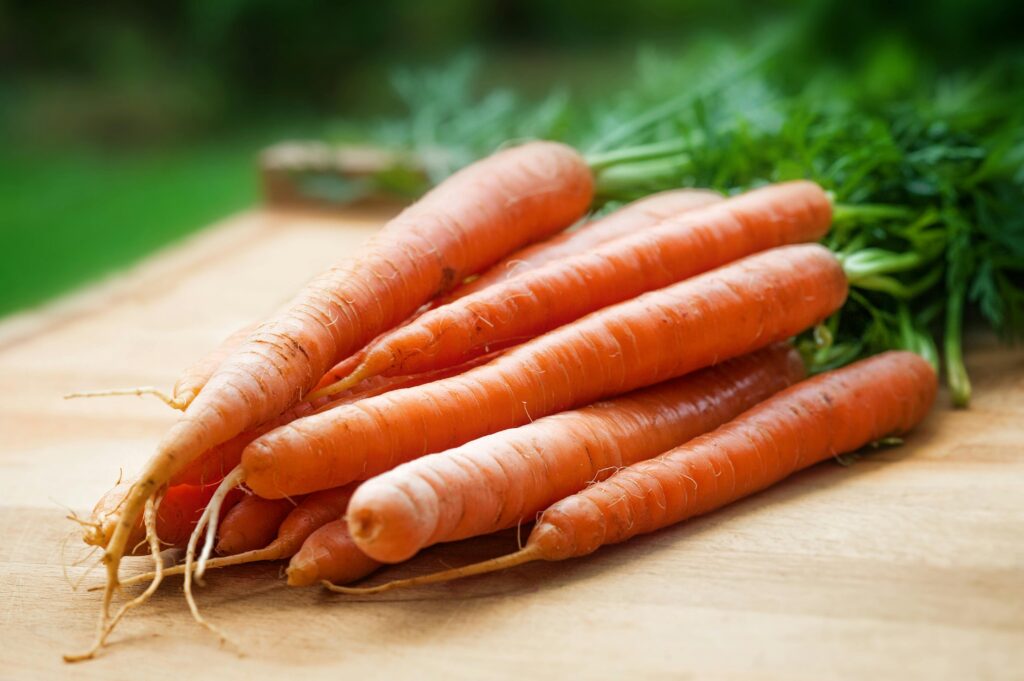
14. Carrots
Carrots are a nutritious, low-calorie vegetable packed with health benefits. They are rich in carotenoids, which may help reduce the risk of certain cancers and improve eye health. In addition, carrots are low in calories, rich in carotenoids for eye health, and provide small amounts of fiber, vitamin K1, and potassium.
Carrots are versatile and can be enjoyed in various ways. You can eat them raw with low-calorie peanut butter for a crunchy snack, or boil them and pair them with a protein source for a simple, healthy meal. Their naturally sweet flavor makes them a favorite for many.
Key Highlights:
- Rich in carotenoids, supporting eye health and potentially reducing cancer risk.
- Good source of fiber, vitamin K1, and potassium.
- Low in calories, making them a great snack or meal addition.
- Versatile for snacking or pairing with proteins.
Who It’s Best For:
- Those looking for a nutrient-dense, low-calorie vegetable.
- Individuals wanting to improve eye health or boost their intake of potassium and fiber.
- People who enjoy versatile vegetables that can be used in various dishes.
15. Broccoli
Broccoli is a nutritious cruciferous vegetable that offers a wealth of health benefits. Packed with fiber, vitamin C, vitamin K, iron, with moderate amounts of iron and potassium for overall health. Despite its impressive nutritional profile, broccoli remains low in calories, making it an ideal addition to any meal plan.
You can enjoy broccoli in many ways, such as roasting it with seasonings like garlic powder and pepper for a simple, flavorful side dish. It’s also great for adding to soups, salads, or stir-fries. Its versatility and low-calorie content make it a staple for anyone looking to eat healthy without consuming too many calories.
Key Highlights:
- High in fiber, vitamin C, vitamin K, iron, and potassium.
- Low in calories, making it perfect for side dishes or meals.
- Versatile for roasting, adding to soups, or mixing into salads.
- Supports immune health and bone strength.
Who It’s Best For:
- Those looking for a low-calorie, nutrient-dense vegetable.
- Individuals seeking to improve their intake of fiber and essential vitamins.
- People who enjoy a versatile vegetable that can be used in many meals.
16. Cucumbers
Cucumbers are a refreshing, low-calorie vegetable that can easily be incorporated into a variety of dishes. With their high water content, cucumbers help with hydration while providing minimal calories. A half-cup of cucumber contains only a small number of calories, making it a perfect addition to salads or a healthy snack.
Beyond their role in meals, cucumbers can also be used to infuse water with a subtle, refreshing flavor, helping you increase your daily water intake. Their versatility and hydrating properties make them an excellent choice for anyone looking to stay full and hydrated without adding many calories.
Key Highlights:
- Very low in calories, mostly made up of water.
- Helps increase hydration and supports daily water intake.
- Versatile for use in salads, snacks, or infused in water.
- Light, refreshing flavor suitable for many dishes.
Who It’s Best For:
- Those looking for a hydrating, low-calorie snack.
- Individuals who enjoy adding a light, refreshing flavor to meals and drinks.
- People seeking an easy way to increase their daily water intake.
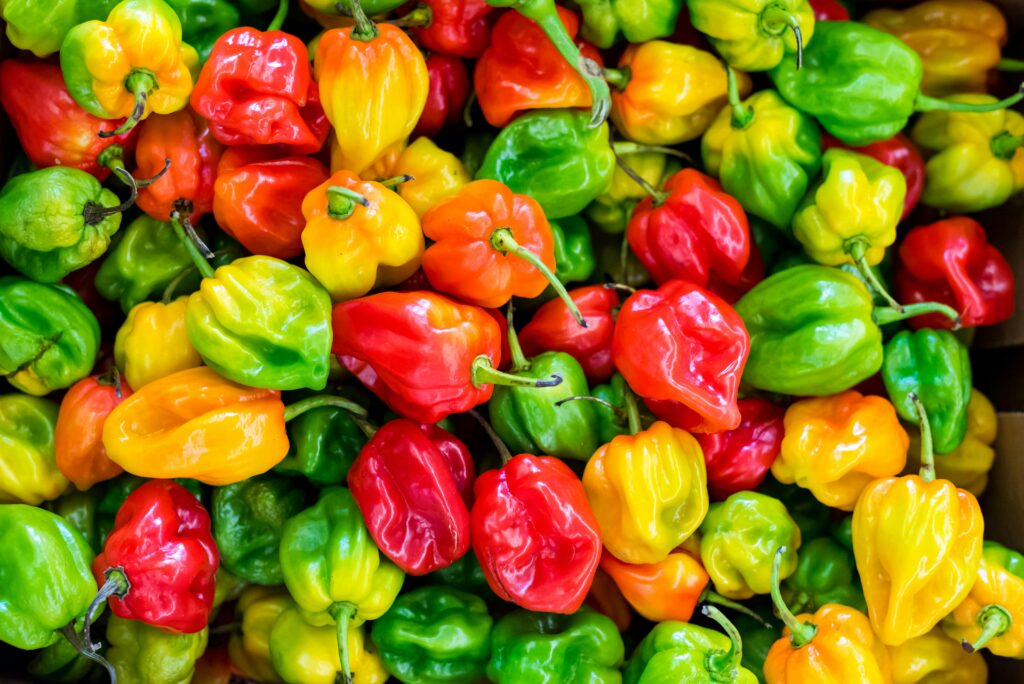
17. Capsicum
Capsicum, also known as bell pepper, is a low-calorie vegetable that packs a punch in terms of nutrition. It’s a great choice for those looking to enjoy a crunchy snack without the calorie load. Capsicum is low in calories, rich in vitamin C, and contains small amounts of antioxidants like lycopene for immune support.
You can enjoy capsicum in a variety of ways, from adding it to salads and stir-fries to simply snacking on it raw. Its sweet, crisp texture makes it an ideal addition to many dishes, helping to add flavor and nutrients without increasing your calorie intake.
Key Highlights:
- Low in calories, making it a great snack or meal addition.
- Rich in antioxidants, including vitamin C and lycopene.
- Sweet, crunchy texture that adds flavor to a variety of dishes.
- Supports immune health and overall well-being.
Who It’s Best For:
- Those looking for a low-calorie, nutritious snack.
- Individuals seeking to increase their intake of antioxidants like vitamin C and lycopene.
- People who enjoy adding flavor and crunch to their meals.
18. Kale
Kale is a highly nutritious, low-calorie leafy green that can be easily added to various meals. With just under 9 calories per cup, it’s an excellent choice for those looking to eat healthily without consuming many calories. Kale is rich in antioxidants, which help protect the body from oxidative damage caused by free radicals. Additionally, it’s packed with important vitamins, including vitamin C, which supports immune function.
You can enjoy kale in salads, smoothies, or even sautéed as a side dish. Its nutritional value and low-calorie content make it a great addition to any diet aimed at maintaining health and well-being.
Key Highlights:
- Very low in calories, making it ideal for calorie-conscious diets.
- Rich in antioxidants, helping to protect the body from oxidative damage.
- High in vitamin C, supporting immune health.
- Versatile for use in salads, smoothies, or as a side dish.
Who It’s Best For:
- Those looking for a nutrient-dense, low-calorie vegetable.
- Individuals seeking to boost their intake of antioxidants and vitamin C.
- People who enjoy adding leafy greens to their meals for extra nutrition.
19. Arugula
Arugula is a low-calorie, nutrient-packed leafy green that’s perfect for adding to salads or other dishes. With just about 5 calories per cup, it offers a light, peppery flavor and a wealth of vitamins and minerals. Arugula is rich in calcium, potassium, folate, and vitamins C, K, and A, all of which contribute to bone health, immune function, and overall well-being.
Thanks to its mild yet tangy taste, arugula pairs well with a variety of ingredients and can be enjoyed in salads, sandwiches, or as a garnish on many meals. Its high nutrient content makes it a valuable addition to any healthy diet.
Key Highlights:
- Very low in calories, making it a great choice for calorie-conscious diets.
- Packed with calcium, potassium, folate, and vitamins C, K, and A.
- Provides a peppery, tangy flavor that enhances dishes.
- Versatile for use in salads, sandwiches, or as a garnish.
Who It’s Best For:
- Those looking for a low-calorie, nutrient-dense leafy green.
- Individuals seeking to increase their intake of vitamins and minerals.
- People who enjoy adding a peppery flavor to their meals.
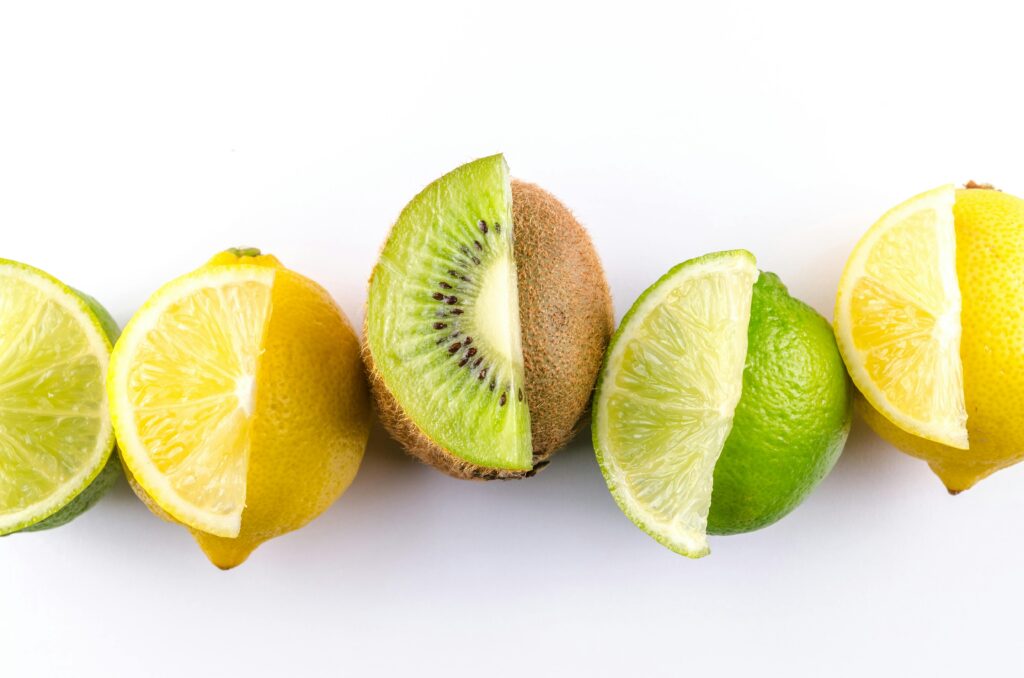
20. Lemon and Lime Juice
Lemon and lime juice are refreshing, low-calorie additions to many dishes and drinks. They provide a burst of citrus flavor with almost no calories, making them an excellent choice for anyone looking to add zest without increasing calorie intake. Whether squeezed over salads, mixed into water for a refreshing drink, or used as a tangy marinade, lemon and lime juice can enhance the flavor of your meals in a healthy, low-calorie way.
In addition to being low in calories, both lemon and lime juice are rich in vitamin C, supporting immune health and providing antioxidant benefits. Their versatility makes them a great way to elevate any dish or beverage while keeping things light and nutritious.
Key Highlights:
- Almost calorie-free, making them ideal for adding flavor without extra calories.
- High in vitamin C, supporting immune function and overall health.
- Versatile for use in salads, drinks, marinades, and more.
- Provides a refreshing citrus taste that complements many dishes.
Who It’s Best For:
- Those looking to add flavor to meals or drinks without adding calories.
- Individuals seeking to boost their vitamin C intake.
- People who enjoy the tangy taste of citrus in their dishes.
Conclusion
Incorporating zero-calorie foods into your diet is a smart way to fill up on nutritious, low-calorie options without compromising on flavor or satisfaction. Whether you’re snacking on crunchy vegetables like cucumbers and radishes, enjoying the sweetness of fruits like strawberries and watermelon, or adding some zest with lemon and lime juice, there are plenty of options to choose from. These foods not only help manage your calorie intake but also provide essential vitamins, minerals, and antioxidants that support overall health.
The best part? Many of these foods are incredibly versatile and easy to add to your daily meals. Whether you’re making a salad, preparing a snack, or cooking a full meal, you can enjoy these ingredients guilt-free. So, the next time you’re looking to eat healthier without the extra calories, turn to these zero-calorie foods to help fuel your body and keep you feeling satisfied.
